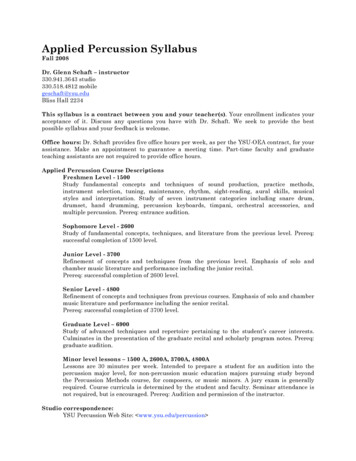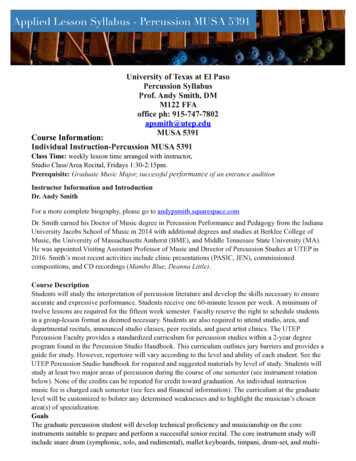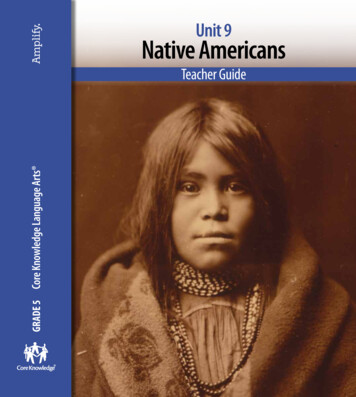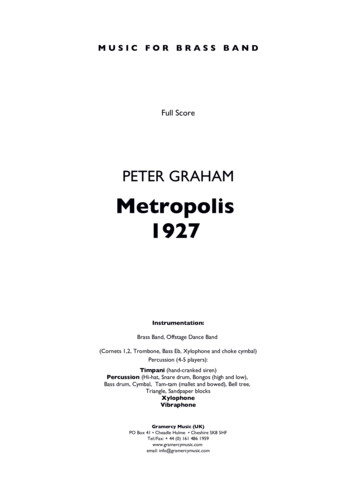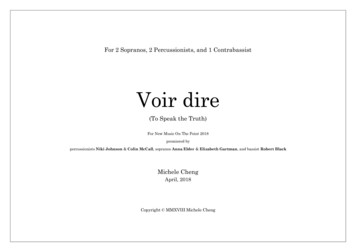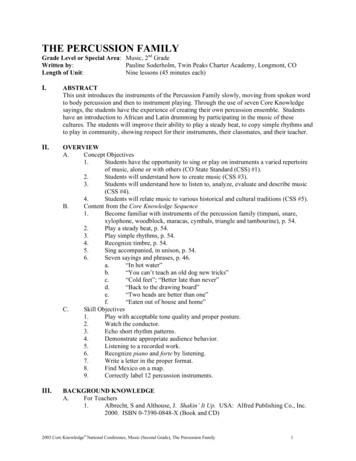
Transcription
THE PERCUSSION FAMILYGrade Level or Special Area: Music, 2nd GradeWritten by:Pauline Soderholm, Twin Peaks Charter Academy, Longmont, COLength of Unit:Nine lessons (45 minutes each)I.ABSTRACTThis unit introduces the instruments of the Percussion Family slowly, moving from spoken wordto body percussion and then to instrument playing. Through the use of seven Core Knowledgesayings, the students have the experience of creating their own percussion ensemble. Studentshave an introduction to African and Latin drumming by participating in the music of thesecultures. The students will improve their ability to play a steady beat, to copy simple rhythms andto play in community, showing respect for their instruments, their classmates, and their teacher.II.OVERVIEWA.Concept Objectives1.Students have the opportunity to sing or play on instruments a varied repertoireof music, alone or with others (CO State Standard (CSS) #1).2.Students will understand how to create music (CSS #3).3.Students will understand how to listen to, analyze, evaluate and describe music(CSS #4).4.Students will relate music to various historical and cultural traditions (CSS #5).B.Content from the Core Knowledge Sequence1.Become familiar with instruments of the percussion family (timpani, snare,xylophone, woodblock, maracas, cymbals, triangle and tambourine), p. 54.2.Play a steady beat, p. 54.3.Play simple rhythms, p. 54.4.Recognize timbre, p. 54.5.Sing accompanied, in unison, p. 54.6.Seven sayings and phrases, p. 46.a.“In hot water”b.“You can’t teach an old dog new tricks”c.“Cold feet”; “Better late than never”d.“Back to the drawing board”e.“Two heads are better than one”f.“Eaten out of house and home”C.Skill Objectives1.Play with acceptable tone quality and proper posture.2.Watch the conductor.3.Echo short rhythm patterns.4.Demonstrate appropriate audience behavior.5.Listening to a recorded work.6.Recognize piano and forte by listening.7.Write a letter in the proper format.8.Find Mexico on a map.9.Correctly label 12 percussion instruments.III.BACKGROUND KNOWLEDGEA.For Teachers1.Albrecht, S and Althouse, J. Shakin’ It Up. USA: Alfred Publishing Co., Inc.2000. ISBN 0-7390-0848-X (Book and CD)2003 Core Knowledge National Conference, Music (Second Grade), The Percussion Family1
2.B.Schmid, W. World Music Drumming. Milwaukee: Hal-Leonard Corporation,1998. ISBN 0-7935-9532-0.For Students1.Recognize a drum by sight and sound, p. 15.2.Locate Mexico and Central America, p. 27.3.Play a steady beat, p.33.4.Echo short rhythms, p. 33.5.Understand that a composer is someone who writes music, p. 33.6.Understand how to write a letter, p. 43.IV.RESOURCESA.“Max Goes to a Concert”, Isaac Millman (Lesson 1)C.CD – Evelyn Glennie’s Greatest Hits UK: RCA, 1998. ASIN B000003EU4. (Lesson 1)D.CD – Carlos Chavez Dorian Recordings ISBN 53479-02152 (In Core Knowledge set ofCDs) (Lesson 5)E.CD – Prokofiev: Peter and the Wolf. Munich: HNH Intl., 1991. ISBN 3009954992.(Lesson 2)F.Shakin’ It Up – Sally K. Albrecht and Jay Althouse (includes CD) (Lessons 1-9)G.Orchestranimals Vlasta van Kampen and Irene C. Eugen, optional (Lesson 2)H.The Cat’s Purr, Ashley Bryan (Lesson 8)I.Zimani’s Drum, Melinda Lilly (Lesson 7)J.Video – Instrumental Classmates – The Percussion Family (Lesson 6)I.Twelve balloons, inflated (Lesson 1)J.Dried beans (Lesson 1)K.Suspended cymbal and a stand (plus 2 yarn mallets) (Lesson 1)L.Teacher drum (All lessons)M.Shakers for each student (Lessons 1,7,8,9)N.Pair of sticks for each student (Lessons 1,9)O.Woodblock or tone block for each student (Lessons 2,9)P.Cymbals (finger and large) to share – as many as you have (Lessons 2,9)Q.Drums and triangles for students to play (Lessons 3,7,8,9)R.Maracas and tambourines for students to play (Lessons 4,7,8,9)S.World map (Lessons 7,8)T.Cowbells and/or agogo bells (Lessons 7,9)U.Latin-American percussion instruments (maracas, claves, bongos, guiro, congas,)(Lesson 8)V.Blank puzzlesV.LESSONSLesson One: Shakers and Sticks (45 minutes)A.Daily Objectives1.Concept Objective(s)a.Students have the opportunity to sing or play on instruments a variedrepertoire of music, alone or with others.b.Students will understand how to create music.2.Lesson Contenta.Become familiar with instruments of the percussion family (timpani,snare, xylophone, woodblock, maracas, cymbals, triangle andtambourine), p. 54.b.Play a steady beat, p. 54.2003 Core Knowledge National Conference, Music (Second Grade), The Percussion Family2
c.d.e.f.B.C.D.Play simple rhythms, p. 54.Recognize timbre, p. 54.Sing accompanied, in unison, p. 54.Sayings and phrases (“In hot water,” “You can’t teach an old dog newtricks”), p. 46.3.Skill Objective(s)a.Play with acceptable tone quality and proper posture.b.Watch the conductor.c.Identify a variety of percussion instruments.d.Echo short rhythm patterns.e.Demonstrate appropriate audience behavior.Materials1.“Max Goes to a Concert”, Isaac Millman2.CD – Evelyn Glennie’s Greatest Hits3.Twelve balloons, inflated4.Dried beans5.Three large drums6.Shakin’ It Up – Sally K. Albrecht and Jay Althouse (includes CD)7.Suspended cymbal and a stand (plus two yarn mallets)8.Shaker and two sticks for each students9.Drum for teacherKey Vocabulary1.Respect – polite consideration for ourselves, others, property and those inauthority (our school-wide definition)2.Shaker – an instrument that makes noise by shaking3.Percussion family – group of instruments that make noise by striking4.Vibrations – motion that causes sound wavesProcedures/Activities1.Students enter quietly while Evelyn Glennie CD is playing. Have students sit ina circle on the floor.2.Introduce the unit by reading “Max Goes to a Concert.” Prepare students byasking the following question: “What family of instruments is featured in thisstory?” After the story, students may have questions and comments.3.Ask the class, “Describe how the deaf students and the percussionist can followthe music.” The answer is that they can feel the vibrations and can interpret whatthe vibrations mean.4.Pass out a balloon to every two students. Have one partner hold the balloon asthe students in the story did (hugged to their chest). Teacher plays a rhythm onthe largest drum available. Switch the balloon and repeat the drum pattern.Continue with several other percussion instruments, switching the balloonbetween each short pattern. You could try it with eyes closed, to focus thechildren’s attention on the vibration in the balloon. Collect the balloons into alarge trash bag.5.Divide students into three groups with a drum for each group. Place “some”beans on each drumhead. Ask the students to “predict what will happen to thebeans when the drum is played.” Number off in the group to determine playingorder and let each have a turn. Last student collects the beans and returns themto the teacher.6.Teacher places a suspended cymbal in the middle of the circle. Ask students to“tell what will happen when the cymbal is struck.” Choose a student to play thecymbal. Demonstrate how to hit the cymbal (at nine and three with two mallets)2003 Core Knowledge National Conference, Music (Second Grade), The Percussion Family3
nt may be able to see the cymbal vibrating. “What will happen when I stopthe cymbal from vibrating?” The sound stops immediately. Help the students tocome to the conclusion that sound is produced by vibrations, which are picked upand interpreted by our ears and brains.Teacher introduces “The Percussion Family” – a group of instruments that areplayed by hitting. Ask the class for examples instruments in the percussionfamily (an informal pre-test). Explain that they will be working with thepercussion family for nine classes. For the first lesson, we will be emphasizingshakers and sticks.Establish a procedure for handing out instruments and putting away theinstruments. Pass out the shakers. Ask the students to place the shakers on thefloor in front of them without playing. Emphasize RESPECT for theinstruments, the leader and fellow-classmates. Teacher may want to use thiscircle quote, “A circle is a symbol of equality; within this we shall find respect.”Any student who participates in a constructive way will be included in the music.Those who don’t will be asked to sit outside the circle until they show respectand are ready to join the class in a team effort. – Adapted from WorldDrumming.Teacher plays an eight-beat pattern and students answer with “I love to drum.”(This should be used to start every class in this unit.) Teacher should play it againand this time students play it on their shakers. Practice this several times untilmost students are successful (knowing when to come in and playing the correctrhythm).New idea: Teacher plays a four-beat pattern and the students echo it. Try severaltimes, changing rhythms, as students seem ready for it.New idea: Teacher plays two-beat patterns from “Shakin’ It Up” and studentsimitate it (four times), see p. 4.Have students put shakers down. Listen to “Shakin’ It Up!” (Track 1) fromShakin’ It Up CD. Listen to the song again and pretend to play shakers.Play CD again and have students play along with their shakers. Repeat as manytimes as you like. Ask students to evaluate their performance. Put down shakers.Introduce the saying “In hot water.” Ask students “What does this mean?” Ifthey have previously covered it in class they will know it. If not, explain that itmeans you are in trouble!Speak the saying in rhythm and ask the students to join you. Transfer the rhythmto body percussion (clapping) while still speaking the words. Transfer therhythm to the shakers. Put shakers down.Pass out the sticks (two sticks per students).Repeat procedure from #9-10. The pattern from the song is eight-beat motive. Itmay be hard for the students to do because of the off beats. Teacher counting outloud while playing may be helpful. Practice hitting with the right sticks over theleft and left stick over the right. Also try hitting the right stick with the left footand vice versa. (These activities are mentioned in the song.) Put sticks down.Listen to “Hit Those Sticks”. (Track 3 – Shakin’ It Up CD)Listen to the CD again, pantomiming playing the sticks.Repeat the song again, playing with the sticks. Repeat as necessary. Put downthe sticks.Introduce the saying “You can’t teach an old dog new tricks”. Repeat procedureabove. Transfer to body percussion and then to sticks. Put down the sticks.Split the class in half. Have half the class speak “In hot water” and the other halfof the class speak “You can’t teach an old dog new tricks”. Then have students2003 Core Knowledge National Conference, Music (Second Grade), The Percussion Family4
E.play it on the instruments (while still speaking the sayings) Switch instrumentsand sayings so each student has a chance to play both parts. Put instrumentsdown.23.Review “percussion family,” “shakers,” and “vibrations.”24.Divide class into several small groups. Have an equal mixture of shakers andsticks in each group. Let each group perform for the class. Remind the class touse appropriate audience behavior. Teacher marks the performance on thegrading sheet, using the rubric. See Appendix B.Assessment/Evaluation1.Teacher evaluation of performance of “In hot water” and “You can’t teach an olddog new tricks” on shakers and sticks, using rubric. See Appendix B.Lesson Two: Woodblocks and Cymbals (45 minutes)A.Daily Objectives1.Concept Objective(s)a.Students have the opportunity to sing or play on instruments a variedrepertoire of music, alone or with others.b.Students will understand how to create music.2.Lesson ContentBecome familiar with instruments of the percussion family (timpani,a.snare, xylophone, woodblock, maracas, cymbals, triangle andtambourine), p. 54.b.Play a steady beat, p. 54.c.Play simple rhythms, p. 54.d.Recognize timbre, p. 54.e.Sing accompanied, in unison, p. 54.f.Sayings and phrases (“Back to the drawing board,” “Cold feet”).3.Skill Objective(s)a.Play with acceptable tone quality and proper posture.b.Watch the conductor.c.Identify a variety of classroom instruments.d.Echo short rhythm patterns.e.Demonstrate appropriate audience behavior.B.Materials1.Woodblock or tone block for each students2.Cymbals (finger and large) to share – as many as you have3.Drum for teacher4.CD Shakin’ It Up5.Orchestranimals Vlasta van Kampen and Irene C. Eugen, optionalC.Key Vocabulary1.Woodblock – rectangular block of wood or classroom instrument substitute2.Cymbal – metal circle, played with a mallet or two struck togetherD.Procedures/Activities1.Play percussion section (Track 40) from Britten’s The Young Person’s Guide tothe Orchestra from CD Prokofiev: Peter and the Wolf, as students enter and sitin a circle on the floor. (In CoreKnowledge set of CDs)2.“What family of instruments do you hear on the CD?” Did you hear anyinstruments that you recognized?”3.Pass out woodblocks and have students place them on the floor in front of them.4.Remind students of the importance of the circle and having RESPECT for theinstruments, their classmates and the leader (teacher). Demonstrate the proper2003 Core Knowledge National Conference, Music (Second Grade), The Percussion Family5
E.playing position for the woodblock and the way to hold the mallet. Do this forall types of woodblocks that you have.5.Play the opening rhythm pattern and have the students respond verbally “I love todrum.” Repeat pattern, but students respond by playing on their woodblock. Ifstudents are sharing instruments, “switch” and repeat for other students.6.Repeat the echoing patterns of Lesson #1.7.Teacher plays first pattern from “Tick Tock”, p. 45 m. 5-8 Shakin’ It Up.Students repeat.8.Teacher play second pattern from “Tick Tock”, p. 45, m. 9-12 Shakin’ It Up.Students repeat. Put instruments down.9.Listen to “Tick Tock”. Repeat with teacher playing in air, students copy and tryto sing.10.Repeat with instruments as many times as is helpful. Put instruments down.11.Introduce the saying “Back to the drawing board”. Use a similar procedure as inLesson #1 – spoken, body percussion, instruments. Put instruments down.12.Introduce “cymbals” to the class. If you have access to crash cymbals orsuspended cymbal, demonstrate for the students. See Appendix C for detailsabout cymbals.13.Pass out what cymbals you have and work out a system so that each student cantry to make the sound.14.Listen to “A Crash Course” from “Shakin’ It Up”. Repeat the procedure frombefore. Most students may be pantomiming the cymbal crashes. Put downinstruments.15.The book, Orchestranimals, would be a fun addition to this lesson since itfeatures a monkey named “Crash”.16.Introduce the saying “Cold Feet” as before. Depending on the number of cymbalsyou have, it may take too much time for everyone to have a turn. Use yourdiscretion. Students may clap the rhythm instead of playing.17.Divide the class into two groups. Practice saying the two sayings together. Playthe two groups of instruments. Put instruments down.18.Review the sayings from Lesson #1. Add “Cold feet” and then “Back to thedrawing board” as students are able. If possible, try it with the instruments (andthe speaking).19.Divide class into groups and handle the assessment using the procedure fromLesson #1.20.Review vocabulary from Lesson #2 – respect, woodblock, cymbal21.Put away all instruments carefully.Assessment/Evaluation1.Rubric for performance of “Cold feet” and “Back to the drawing board” usingcymbals and woodblocks.Lesson Three: Drum and Triangle (45 minutes)A.Daily Objectives1.Concept Objective(s)a.Students will have the opportunity to sing or play on instruments a variedrepertoire of music, alone or with others.b.Students will understand how to create music.2.Lesson Contenta.Become familiar with instruments of the percussion family (timpani,snare, xylophone, woodblock, maracas, cymbals, triangle andtambourine), p. 54.2003 Core Knowledge National Conference, Music (Second Grade), The Percussion Family6
B.C.D.b.Play a steady beat, p. 54.c.Play simple rhythms, p. 54.d.Recognize timbre, p. 54.e.Sing accompanied, in unison, p. 54.f.Sayings and phrases (“Two heads are better than one”), p. 46.3.Skill Objective(s)a.Play with acceptable tone quality and proper posture.b.Watch the conductor.c.Identify a variety of percussion instruments.d.Echo short rhythm patterns.e.Demonstrate appropriate audience behavior.Materials1.Drums and triangles for students to play2.Drum for teacher3.CD – Shakin’ It UpKey Vocabulary1.Drum – a cylinder frame with at least one head2.Triangle – metal instrument shaped in form of triangle3.Listen - hearing with thinkingProcedures/Activities1.Play CD as students enter to sit in a circle.2.Pass out drums. One for each student would be ideal, but one for every two isadequate. Work out a system for the process of switching players on the drum.Teacher introduces “drum,” see Appendix C. Remember to mention snare drumand bass drum. Show instruments or pictures.3.Teacher plays welcoming rhythm pattern and students respond with “I love todrum.” Repeat, answering on the drum.4.Repeat procedure of echoing. One possible game dealing with names is in WorldDrumming, p. 17.5.Teacher plays rhythm pattern #1 from “Rum Ba Da Dum Bum Bum”. Shakin’ ItUp, p. 47, m. 2-3. Students echo.6.Teacher plays rhythm pattern #2. Shakin’ It Up, p. 47, m. 12. Students echo.7.Teacher plays rhythm pattern #3. Shakin’ It Up, p. 47, m. 9. Students echo.8.Listen to “Rum Ba Da Dum Bam Bum”. Listen again and pantomime drumming.9.Repeat song, playing on the drums. Repeat as necessary (and fun). Put downinstruments.10.Introduce the saying “Two heads are better than one” as before. Remember touse spoken word, body percussion and then to the drum. Put down instruments.11.Teacher introduces the triangle. Demonstrate the proper playing position for asingle hit and a roll. Work out a system to share the triangles that you have.12.Teacher plays first rhythm pattern, Shakin’ It Up, p. and students echo.13.Repeat process of listening and pantomiming for “It’s Time For Dinner.” Putinstruments down.14.Review all the sayings from Lessons #1-3. Starting with “Cold Feet” add themone at a time. Remember spoken word, body percussion and then instruments.Triangle joins cymbals on “cold feet”. If the roll from the song has beensuccessful, you might roll “cold” and hit on feet. Otherwise, a single hit on eachword is great! Put down instruments.15.Divide class and have them perform “Two heads are better than one” and “coldfeet” on drums and triangles. Assess as before.16.Review “triangle.”2003 Core Knowledge National Conference, Music (Second Grade), The Percussion Family7
E.17.Put away instruments.Assessment/Evaluation1.Rubric performance of “Two heads are better than one” and “cold feet.”Lesson Four: Maracas and Tambourine (45 minutes)A.Daily Objectives1.Concept Objective(s)a.Students will have the opportunity to sing or play on instruments a variedrepertoire of music, alone or with others.b.Students will understand how to create music.2.Lesson Contenta.Become familiar with instruments of the percussion family (timpani,snare, xylophone, woodblock, maracas, cymbals, triangle andtambourine), p. 54.b.Play a steady beat, p. 54.c.Play simple rhythms, p. 54.d.Recognize timbre, p. 54.e.Sing accompanied, in unison, p. 54.f.Sayings and phrases (“Eaten out of house and home” and “Better latethan never”), p. 46.3.Skill Objective(s)a.Play with acceptable tone quality and proper posture.b.Watch the conductor.c.Identify a variety of percussion instruments.d.Echo short rhythm patterns.e.Demonstrate appropriate audience behavior.B.Materials1.Maracas and tambourines for students to play2.CD – Shakin’ It Up3.Teacher drumC.Key Vocabulary1.Maracas – Set of two rattles with handles2.Tambourine – hand-held drum with metal jingles attached3.Percussion Ensemble – group of players playing percussion instrumentsD.Procedures/Activities1.Students enter to sit in a circle.2.Remind students about the circle, its significance and respect for the instruments,classmates and the teacher.3.Pass out the maracas. Use a system to share the instruments. It takes twomaracas to play the rhythm. Teacher introduces the maracas and demonstratesthe proper playing technique. See Appendix C.4.Teacher plays the welcome rhythm and students answer, “I love to drum.”Repeat and have students respond with maracas. Repeat so everyone has achance to play on the instruments.5.Practice various echo/response rhythms at your discretion.6.Teacher plays pattern #1 from “Shake My Maracas”. Shakin’ It Up, p. 48, m. 34. Students copy.7.Teacher plays pattern #2. Shakin’ It Up, p. 48, m. 9. (This is a repeat patternfrom the previous lesson) Students copy.2003 Core Knowledge National Conference, Music (Second Grade), The Percussion Family8
8.E.Listen to CD “Shake My Maracas” and follow the procedure as in previouslessons. When everyone has had a turn to play with the CD, put the instrumentsdown.9.Introduce the saying “Eaten out of house and home” as in previous lessons.Teach in the spoken form, transfer to body percussion and then try it on themaracas. When everyone has had a chance to play on the maracas, put theinstruments down.10.Teacher introduces the tambourine and shows the proper playing techniques. SeeAppendix C.11.Do several echo patterns to see that students understand the playing techniques.12.Listen to “My New Tambourine”. Mime through the song and work up toplaying with the tambourine. This is quite a difficult song because the patternchanges during the song. You may have to modify or adlib the tambourine part ifit is too difficult for the students.13.Introduce the saying “Better late than never.” Follow the same procedures aswith the other instruments.14.Review all of the sayings. Speak, and then add the body percussion. Divide theclass into seven groups and speak all sayings.15.Have the students get their instruments and perform it with instruments. Withconducting motions, teacher should indicate playing everything softer, louder,slower, faster, adding a crescendo, decrescendo.16.Ask for student input – “How did it sound when we played it piano? Forte?Describe how it sounded when we played it slower? Faster? How did it soundwhen we put in a crescendo, decrescendo? Use the precise musical terminologyat this point if students have a background with it. Label this musical creation asa “Percussion Ensemble.”17.Put all the percussion instruments away except the tambourines and maracas.18.Perform the two new sayings in small groups – “Eaten out of house and home”and “Better late than never.”19.Evaluate the performances with the rubric. Put instruments away.Assessment/Evaluation1.Evaluation of student performancesLesson Five: Carlos Chavez and the Percussion Ensemble (45 minutes)A.Daily Objectives1.Concept Objective(s)a.Students will listen to, analyze, evaluate and describe music.b.Students will relate music to various historical and cultural traditions.2.Lesson Contenta.Become familiar with instruments of the percussion family (timpani,snare, xylophone, woodblock, maracas, cymbals, triangle andtambourine), p. 54.b.Recognize timbre, p. 54.c.Carlos Chavez, Toccata for Percussion, third movement, p. 54.d.Locate: Mexico, p. 47.e.Produce a letter, p. 43.3.Skill Objective(s)a.Listen to a recorded work.b.Recognize piano and forte by listening.c.Write a letter in the proper format.d.Find Mexico on a map.2003 Core Knowledge National Conference, Music (Second Grade), The Percussion Family9
B.C.D.F.Materials1.CD – Carlos Chavez2.World map3.Appendix E: Student worksheet for Carlos Chavez4.Pencil and hard surface to write on5.Puzzle packets – information from Chavez written on blank puzzles (one for eachgroup of four)Key Vocabulary1.Listen – hear with thinking2.Composer – one who writes music3.Mexico City, Mexico – capitol of Mexico4.Percussion Ensemble – group playing in percussion instrumentsProcedures/Activities1.Play Chavez CD as students enter. “What kind of music is playing ?” “Can youname an instrument that you hear?” Review “Percussion Ensemble” “Did youhear any instrument that we had in our percussion ensemble?”2.Introduce Carlos Chavez. See Appendix D. Emphasize the meaning of“composer”. Chavez spoke Spanish and is one of the most famous Mexicancomposers. Show Mexico City, Mexico, on a map.3.Explain the procedure for the activity. Each group will get a packet. As a teamthey should put together the puzzle and choose one of the group to read thewords OUT LOUD. Each student should fill out his own paper, but the studentsshould help each other. For Part II, play the CD and allow the students to fill inthe questions. The third part of the activity is to write a letter to a relative orfriend explaining what they have learned about Chavez and what his musicsounds like. They should include a personal opinion about how the musicsounds. Remind the students about the correct letter form: Dear ,indent first line, closing is on a separate line followed by a comma, and name ona separate line.4.Divide the class into groups of four. Pass out supplies (Carlos Chavez, AppendixE, pencil and hard surface, packet with puzzle).5.Teacher should monitor groups to help with reading.6.Play the CD when all groups are finished with Part I.7.Give help for letters as needed.8.Students should turn in all supplies.Assessment/Evaluation1.Written worksheetLesson Six:Meeting Other Instruments in the Percussion Family (45 minutes)A.Daily Objectives1.Concept Objective(s)a.Students will have the opportunity to sing or play on instruments a variedrepertoire of music, alone or with others.b.Students will understand how to listen to, analyze, evaluate and describemusic.c.Students will relate music to various historical and cultural traditions.2.Lesson Contenta.Become familiar with instruments of the percussion family (timpani,snare, xylophone, woodblock, maracas, cymbals, triangle andtambourine), p. 54.b.Recognize timbre, p. 542003 Core Knowledge National Conference, Music (Second Grade), The Percussion Family10
3.B.C.D.E.Skill Objective(s)a.Correctly label 12 percussion instrumentsMaterials1.Video – Instrumental Classmates –Percussion2.Appendix F: Percussion Book for each studentKey Vocabulary1.Timpani – large drum with copper base whose pitch can be changed2.Xylophone – keyboard instrument with wooden keys3.Snare drum – two-headed drum with snares on the bottom head4.Bass drum – large two-headed drumProcedures/Activities1.Review vocabulary from previous lessons Review all the sayings from the firstfour lessons and perform as a vocal ensemble (spoken).2.Introduce the new vocabulary. If you have these instruments, it would be helpfulto show the real instruments. Instrument posters are an adequate substitute.3.Watch the video (30 minutes).4.“Summarize what you have learned about the percussion family from watchingthe video”. “Can you classify the many kinds of instruments in this family?”“What is the function of the percussion family in a musical group?”5.Explain the activity for the rest of the period. Each student will need apercussion book, crayons and a hard surface to write on. The student shouldlabel each instrument from the words in the key box. They could color theinstruments and decorate appropriately the cover sheet. Students can help eachother with the labeling. If there is extra time, students could quiz a partner on thenames of the instruments.Assessment/Evaluation1.Teacher evaluation of the completed percussion book, using the rubricLesson Seven: African Drumming (45 minutes)A.Daily Objectives1.Concept Objective(s)a.Students will have the opportunity to sing or play on instruments a variedrepertoire of music, alone or with others.b.Students will understand how to listen to, analyze, evaluate and describemusic.c.Students will relate music to various historical and cultural traditions.2.Lesson Contenta.Introduce African drumming, p. 54.b.Locate: Africa, p. 47.c.Play a steady beat, p. 54.d.Play simple rhythms, p. 54.3.Skill Objective(s)a.Play with acceptable tone quality and proper posture.b.Watch the conductor (leader).c.Play a steady beat.d.Play simple rhythms of Africa.B.Materials1.Teacher drum2.Zimani’s Drum, Melinda Lilly3.Shaker for each student4.Selected drums for student use2003 Core Knowledge National Conference, Music (Second Grade), The Percussion Family11
C.D.E.5.Cowbells and/or agogo bells6.World map7.Appendix F: Percussion booksKey Vocabulary1.Community – group united for some purpose2.Djembe – African drum3.Shekere – African shaker4.Talking drum – African drum shaped like an hourglass5.Agogo bells – Large and small metal bells that are connected togetherProcedures/Activities1.Play a CD of African drumming as students enter to sit in a circle on the floor,optional.2.Read Zimani’s Drum as an introduction to drum.3.Choose a student to locate Africa on a world map. Teacher should point outWest Africa, where many of the traditions come from that we in the West arefamiliar. Locate Malawi, the country of Zimani’s Drum.4.Introduce students to the place of “drum” in African culture. See Appendix C fordetailed information.5.Review the idea of “circle” used in the earlier lessons. In African culture,dancing, drumming and singing are often done in a circle. This emphasizes“community”. Several African proverbs speak to community – “ A singlebracelet does not jingle.” Zaire, “When spider webs unite, they can tie up a lion.”Ethiopia, “Two eyes see better than one.” Mauritania. (World Drumming, p.48).6.Demonstrate keeping a steady beat with a shaker. Pass out shakers and letstudents try. At first teacher plays steady beat with the students, then addsimprovisation on the drum. Check to see if students can hold the beat.7.Demonstrate African movement – Start with feet together, step right foot out onone, left foot out on two, step in with right foot on three and left foot on four.Knees slightly be
L. Teacher drum (All lessons) M. Shakers for each student (Lessons 1,7,8,9) N. Pair of sticks for each student (Lessons 1,9) O. Woodblock or tone block for each student (Lessons 2,9) P. Cymbals (finger and large) to share - as many as you have (Lessons 2,9) Q. Drums and triangles for students to play (Lessons 3,7,8,9)


